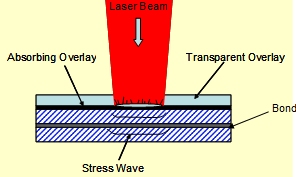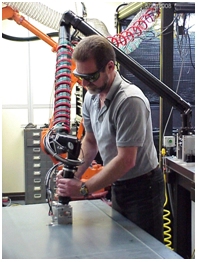Laser Bond Inspection (LBI) – FAQs
Frequently Asked Questions About LBI
Posted: August 20, 2008
By: wpengine
Frequently Asked Questions About LBI
What is Laser Bond Inspection?
Laser Bond Inspection (LBI) is a new nondestructive evaluation (NDE) technology for testing the integrity of bonded materials and structures. The technology utilizes an advanced, high energy, pulsed laser system developed by LSP Technologies and specifically tailored for evaluating adhesively-bonded composite structures.
Why not use conventional NDE techniques such as ultrasonic inspection or radiography?
Conventional NDE techniques are useful when a gap, crack, or void is present in a bonded material. However, these techniques cannot identify problems, such as “kissing bonds” where the bonded materials are in contact but without structural strength. These problems can result from surface contamination, improperly mixed or outdated adhesives, or improper adhesive application techniques.
How does Laser Bond Inspection work?
Laser Bond Inspection (LBI) is a proof-testing method that sends a precisely-controlled dynamic stress wave through an adhesive bond of a composite structure. The process involves the deposition of laser energy at the front surface of the structure, which generates a compressive stress wave (See Figure 1). The compressive stress wave propagates to the back surface of structure were it is reflected as a tensile wave. The tensile wave propagates back through the structure and it stresses the bond lines. The application of the dynamic stress on the composite material is low enough to have no effect on the integrity of the material or bond when it is properly constructed. However, when the bond is substandard, the stress wave will cause the bond to fail, and a sensor in the LBI system process head detects the failure (See Figure 2).
LBI technology can be used during the initial construction of the structure and during subsequent inspections throughout the life of the structure. The technique offers a practical structural health monitoring solution for identifying and locating composite damage/defect regions in laminate and laminate-adhesive bonds in aircraft.
Figure 1. Schematic of the Laser Bond Inspection (LBI) Process.
Figure 2. LBI System Process Arm and Inspection Head.
What types of bonded structures can be inspected?
Most applications tested to date have involved composite-composite bonds. However, LBI has also successfully identified defective metal-to-metal and composite-to-metal bonds.
What are the uses for LBI technology?
The initial uses for LBI have focused on inspecting adhesively-bonded, laminated composite structures for aerospace applications. The integrity of composite structures is increasing in importance because composites are being used in aircraft construction at an accelerating rate to reduce weight and improve fuel efficiency. The presence of material bond defects in composite aircraft structures can lead to disastrous failure of the structure under flight loads. These defects may be in the composite laminate itself or in adhesive bonds in the structure, and may arise as a result of damage during service, or in the original manufacturing process through production error.
In addition to flight-critical components, LBI is expected to find broader use for testing composites and other bonded materials used in automotive/truck, medical, and energy production applications.
Furthermore, the laser bond inspection process can also be adapted to induce intentional defects in prototype composite structures. This technique allows a structure to be evaluated for fatigue issues before it is flight tested.
Are LBI systems portable?
LSPT’s LBI system has now been configured in a self-contained, enclosure that sits on a mobile platform. This design facilitates rapid insertion of the LBI process into manufacturing plant operations and maintenance depots. No equivalent laser system exists in the commercial sector.

Is LBI technology a stand-alone inspection method for composites?
No. The inspection technology can to be used determine the strength of a bond line and should be used in conjunction with the typical ultrasonic methods to inspect for other gross abnormalities in the bond line such as porosity.
Is LBI technology recommended for use in the construction of components?
Laser Bond Inspection can be used to evaluate bond lines in all stages of the construction of a composite structure. This is important when there is a possibility that the area to be inspected will be “closed out” with the addition of other structures.
LBI technology can also be used during subsequent maintenance inspections to determine the integrity of the bond during the service life of the component.
Is LBI a proprietary technology?
Yes. The concept of Laser Bond Inspection was invented by Boeing. However, LBI technology and the related laser system equipment were developed and refined for practical use by LSP Technologies. LSPT controls the intellectual property required for extending LBI laser systems to new applications.
How mature is LBI technology?
LBI is an emerging technology. LSPT has built a laboratory LBI system, and is now completing the build of the first mobile LBI system under an Air Force SBIR II program. LBI testing is ongoing for several major aerospace companies. These tests indicate that LBI is a robust NDE technology suitable for use in production or maintenance operations.
How can I learn more about Laser Bond Inspection?
Please contact David Lahrman, Director of Business Development, at 614-718-3000 x244 dlahrman@lspt.com.
Interested in Seeing More?
Tell us about your application, material, or failure mechanism and we will have one of our experts reach out to you. Our extensive library of research and years of experience gives us a unique advantage to apply a finite element analysis to help diagnose the best application for your situation.


